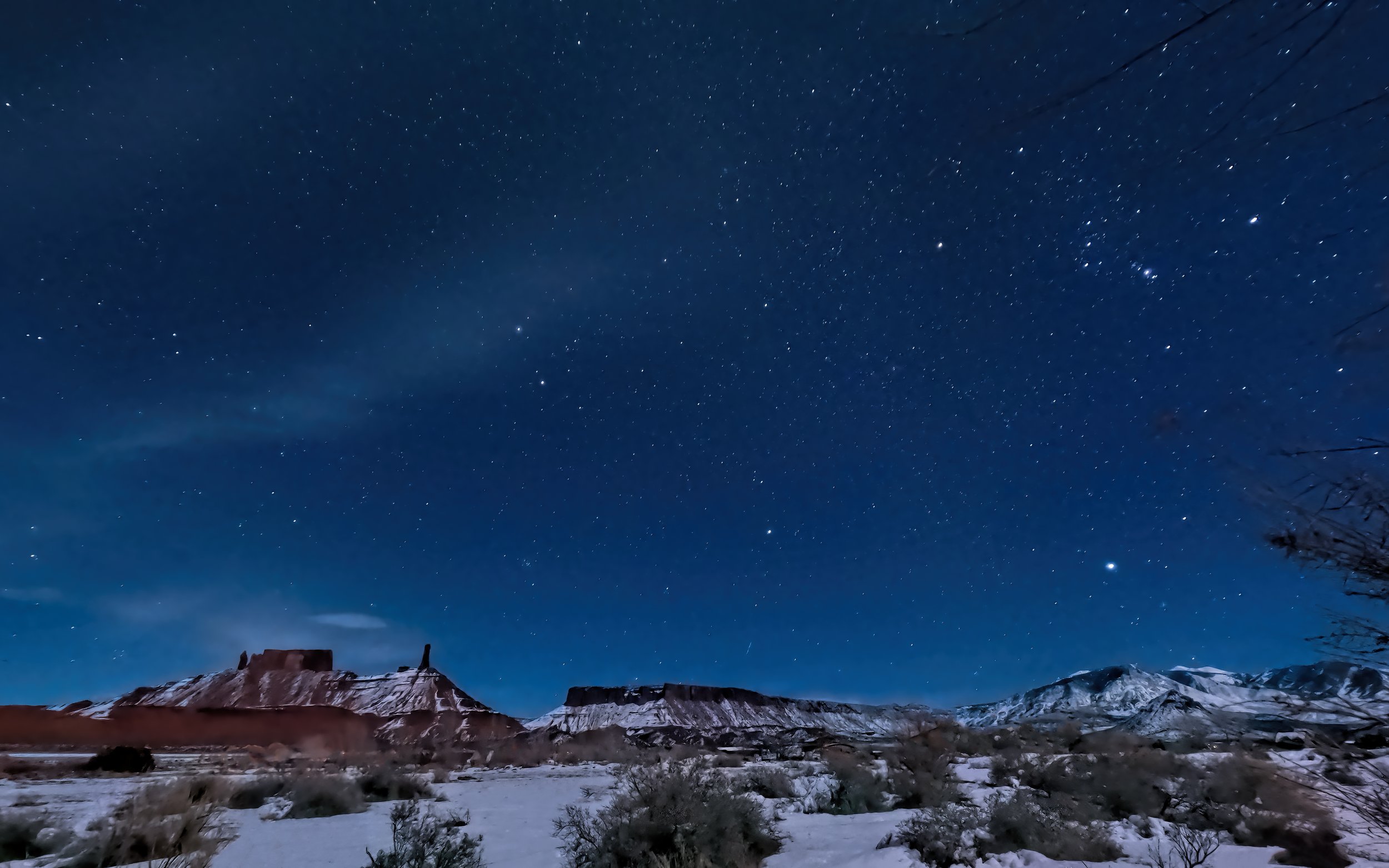Sharp-shinned Hawk (Accipiter striatus).
A perfectly pecked petroglyph...
of an enormous owl, gazing unblinking for centuries over Kane Creek Canyon.
The owl glyph is about two feet (0.6 meters) tall.
Exquisite detail in a couple of bighorn sheep glyphs.
Six more weeks of winter...
is forecast by these Wild Turkeys who saw their shadow early this morning in Castle Valley.
Female Wild Turkey (Meleagris gallopavo).
A well camouflaged rabbit...
foraging in the underbrush.
Desert cottontail (Sylvilagus audubonii).
Significant progress has been made...
on the Moab Uranium Mill Tailings Remedial Action (UMTRA) Project where nearly 80% of contaminated tailings and soils have been removed since 2009, relocated about 30 miles to the north at a disposal site near Crescent Junction, Utah. Here are the numbers and a project overview.
A glowing snowscape...
dimly illuminated by the new Moon, with Orion hovering above Castle Valley.
A cold and starry night...
descends upon Castle Valley, Utah, now a third of the way through winter.
One frame of a “nightlapse” shot on my GoPro Hero 9 Black shortly after sundown. Thirty second exposure at ISO 1600.
The high country slowly revealed...
showing where large cornices have been constructed from the historical record snowpack that has accumulated.
Scenic snowy landscapes...
may persist in the canyons in the Moab area for the week ahead, with frigid temperatures but little moisture predicted in the forecast.
The view from the window...
the morning after a winter storm, revealing a snowy blanket on the landscape and fully-flocked trees.
The snow water equivalent at the La Sal Mountain SNOTEL site is reporting 228% of the median value on this date based on 41 years of record! (Link to real time data.)
Riding out the storm...
but staying close to the feeding station while fluffy snowflakes fall. This round of moisture puts the La Sal Mountains at well over 200% of the median snow water content for this date.
White-crowned Sparrow (Zonotrichia leucophrys).
A magnificent wintry wonderland...
at Bryce Canyon National Park, freshly dusted and dressed with snow from a recent winter storm.
The iron oxide-rich Eocene-aged Claron Formation takes on a luminous quality due to the soft reflected light.
Hundreds of hoodoos stand as sentinels on the snowy landscape.
The Henry Mountains and Waterpocket Fold catching the last rays of the day.
It was a leisurely exploration...
on a delightful winter day with two friends in Gold Bar (Culvert) Canyon west of Moab. A continually ascending trail tops out at Gold Bar Arch, also known as Jeep Arch, after two miles with stunning views of the distant snowcapped La Sal Mountains.
Gold Bar Spire is a prominent landmark on the trail.
The opening of Gold Bar or Jeep Arch is about 45 feet (14 meters) high and about 66 feet (20 meters) wide.
A moody moonrise...
marks the first full lunar orb of the new year, as well as one of the smallest, the Wolf Moon.
The story of a bear hunt...
being literally depicted as a detailed petroglyph at the base of a tall sandstone wall along Potash Road. I think the interpretation of this panel is pretty clear.
The bear glyph itself is enormous, approximately six feet (two meters) across. Note the use of bow and arrows by the several hunters surrounding it, suggesting that this is related to the Fremont culture, placing it over the older bighorn sheep glyphs of Basketmaker origin.
The dusky stage is being set...
for the first full moonrise of the new year, the so-called Wolf’s Moon, still several days away. Still time to practice my howl.
A skyline on fire...
at sunset on New Year’s Day. A vibrant and welcome relief to an otherwise gray day. It doesn’t suck.
Pop goes the alignment...
of a shadow cast at the winter solstice sunrise, instantly corresponding to an etched line on a rock art panel on Potash Road near Moab, Utah. As impressive as it was to witness in person, it’s considerably more dramatic in this time-compressed video clip shot on my GoPro:
The brief clip (above) is about a one minute-long edited time-lapse of the moment of sunrise on the petroglyph panel on the morning of 21 December 2022.
A snowy blanket...
extends from the highest peaks to the valley bottom, the result of a winter storm that has passed through the area, dropping more than an inch of rain on Castle Valley.
UPDATE: Mid-day, after the storm. It’s lovely but terribly muddy.
Snow water equivalent time series for the LaSal Mountain SNOTEL site (link to current data). Black line is current water year while the blue line shows the previous water year. Green line indicates the median.
Solstice spirits danced on the rock walls...
along Potash Road at sunrise this morning, celebrating a clear dawn for witnessing a most impressive solar alignment between a shadow line and ancient rock art.
Predawn on the frazil ice-covered Colorado River.
Our inspirational leader, Rory Tyler. Link to his presentation on The Potash Panels - Frontiers in Rock Art Analysis.
Panel showing spirit bear paw petroglyph (half in shadow on the left) with the winter solstice shadow aligning perfectly with scribed lines on the sandstone.
Wider view of the panel, with the vertical rib of rock serving as the gnomon shown illuminated on the left.
Annotated non-sunlit image of the panel showing highlighted dotted line A that follows a scribed line on the petroglyph of the spirit bear claw that corresponds to the shadow cast during the winter solstice. Color differences seen here are due to variations in the desert varnish. There was undeniably an ancient astronomer at work here hundreds to a thousand years ago to have etched this precise line. Cool beans.
Screengrab from a GoPro time-lapse of the shadow line popping into place at the moment of solstice sunrise. Like I said, cool beans.







































